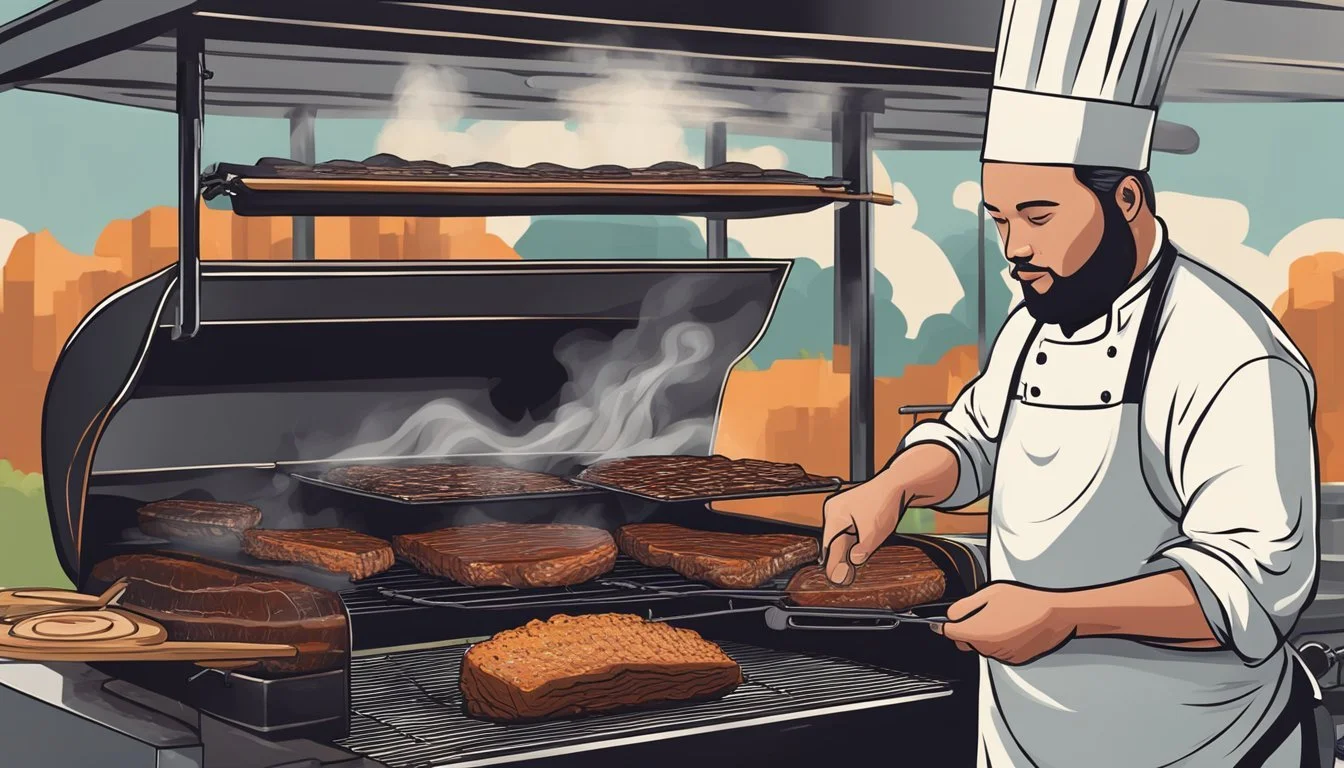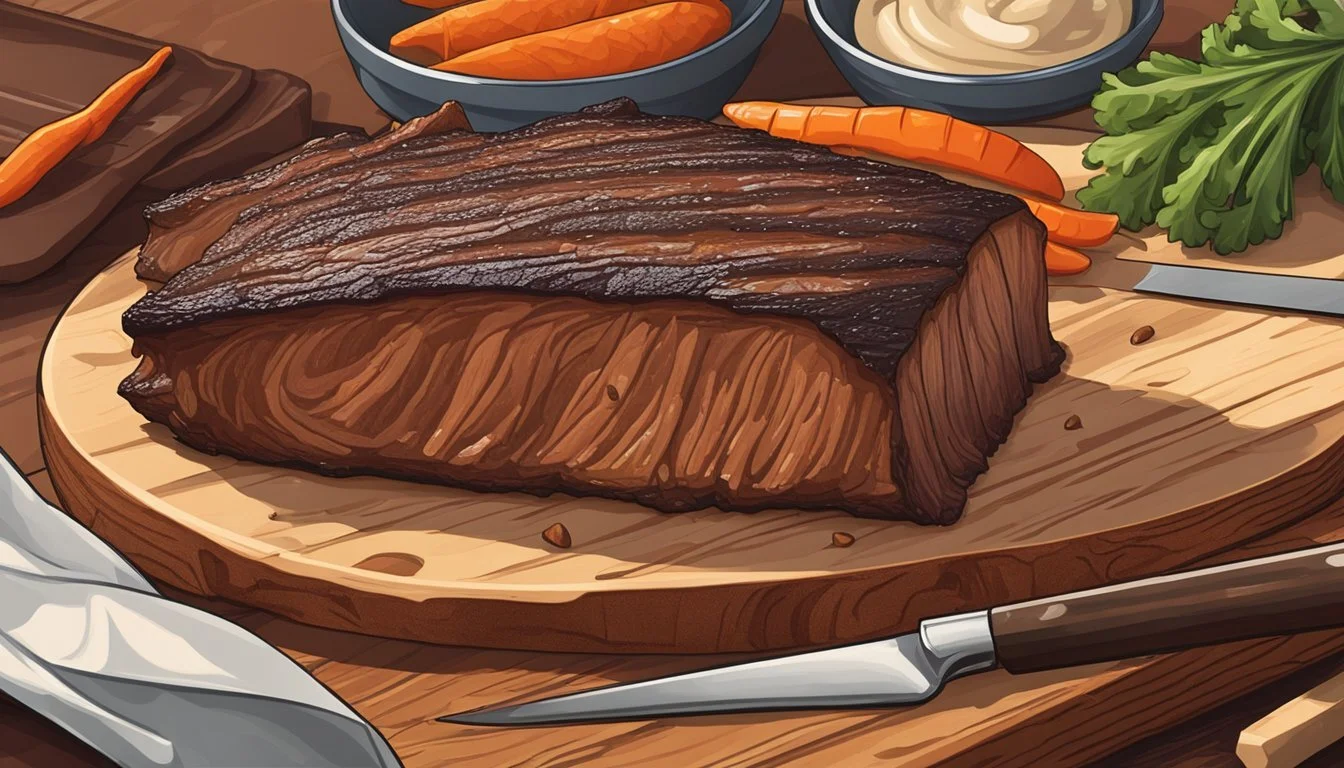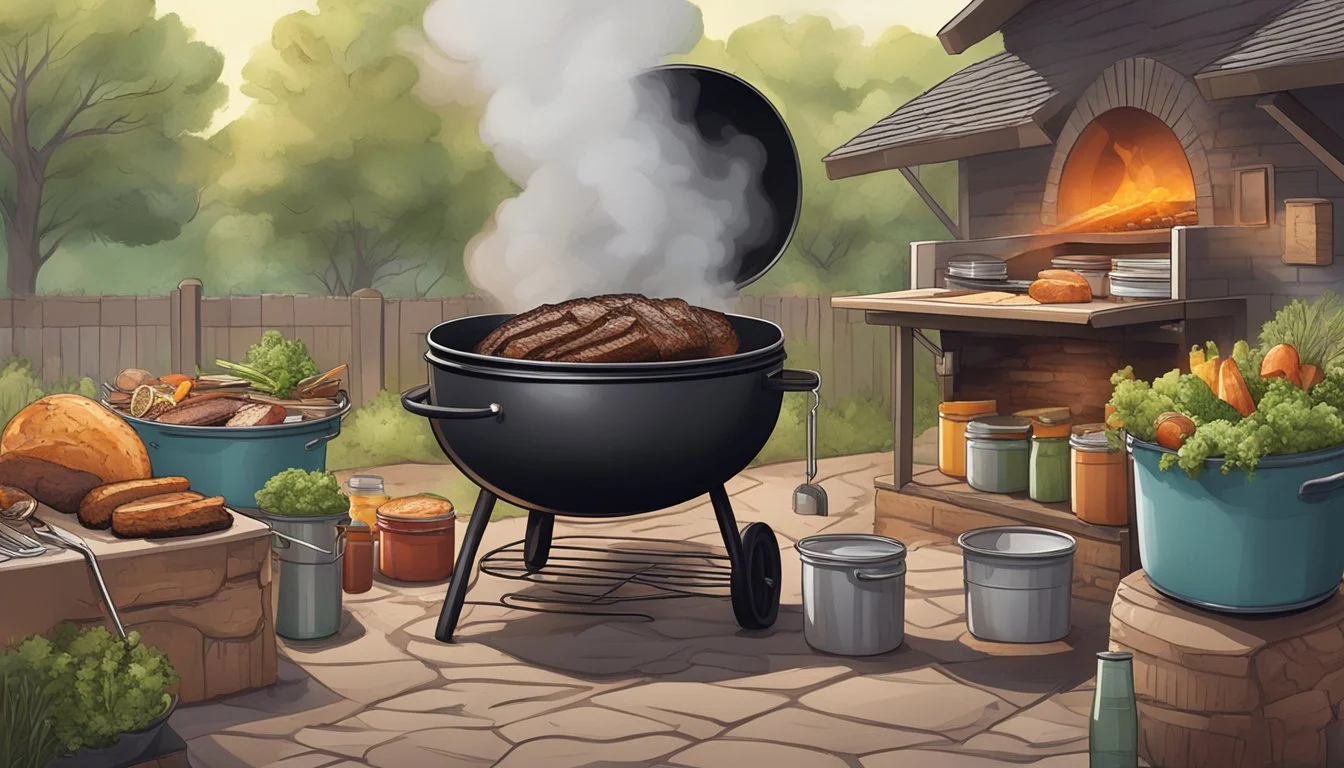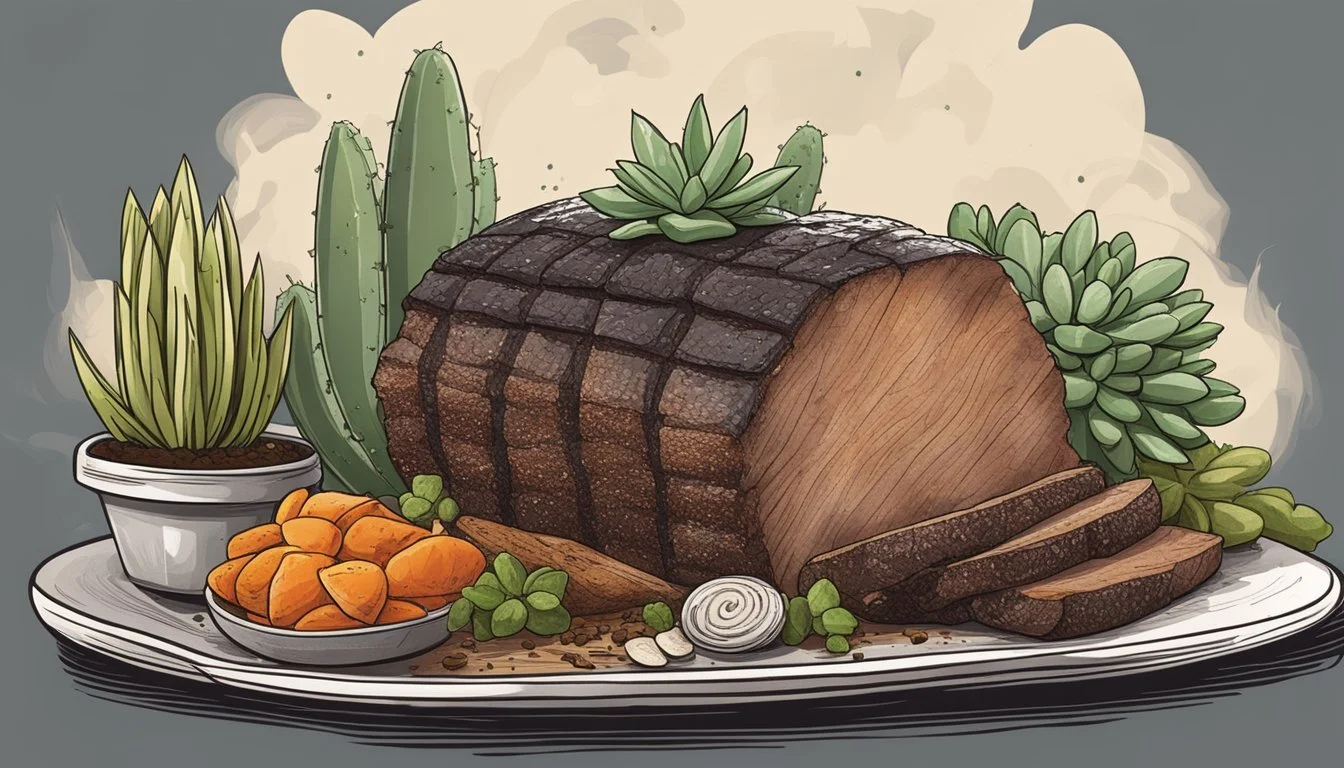Low and Slow
BBQ Brisket for Easter - Your Ultimate Guide to Holiday Perfection
Beef brisket (What wine goes well with beef brisket?) stands as a hallmark of barbecue (What wine goes well with barbecue?) excellence, an embodiment of low and slow cooking philosophy that rewards patience with succulent results. Traditionally associated with Texas-style barbecue, brisket is a cut that benefits from a lengthy cook at a gentle heat, allowing the tough connective tissues to break down into melt-in-the-mouth tenderness. Choosing the right piece of meat is crucial; chefs look for a brisket with even marbling and a good layer of fat, which contributes to both the flavor and moisture during the cooking process.
Cooking a beef brisket for Easter offers an opportune moment to showcase the transformative power of low temperature and time. The oven serves as an accessible tool for indoor cooking, providing consistent heat that can mimic a barbecue pit. A carefully monitored temperature, typically around 250 degrees Fahrenheit, is essential to achieve the optimum texture. The brisket's surface is often prepared with a spice rub or a slathering of BBQ sauce to form a flavorful crust, further sealed in by a wrapping of parchment and foil that aides in the meat's self-basting.
The celebration of Easter calls for a dish that can be shared amongst family and friends, and a well-prepared beef brisket answers this call with its generous size and rich flavor profile. As the brisket slowly roasts in the oven, its aroma hints at the upcoming feast. After a significant stretch of time, the brisket reaches the peak of its tenderness – often checked by probing to a precise internal temperature of 190 degrees Fahrenheit. Before making its way to the table, it is essential to let the meat rest allowing the juices to redistribute, ensuring each slice is as flavorful and tender as possible.
Selecting the Perfect Brisket
When preparing BBQ brisket for Easter, the cut of beef chosen is paramount. Selection involves understanding the various beef cuts, assessing the quality grades, and optimizing the brisket's fat content for the best results.
Understanding Beef Cuts
Brisket is a cut of beef from the lower chest or pectoral muscles of the cow. It is known for its rich flavor and connective tissue, which, when cooked low and slow, becomes tender. There are mainly two cuts to consider:
Packer Cut: This includes both the 'point' and 'flat' and is generally larger, containing more fat.
Flat Cut: Also known as the 'first cut', it's leaner and more uniform in thickness, which may lead to easier cooking and slicing.
When purchasing from places like Costco, customers often find these brisket cuts readily available, giving ample choice based on preference and need.
Brisket Grades and Quality
In the United States, brisket is graded by the USDA, which indicates its quality:
Grade Description Prime High in marbling and tenderness; superior in quality. Choice Less marbling than Prime, but still of high quality. Select Leanest grade with less juiciness and tenderness.
One should aim for at least Choice grade brisket, while Prime grade offers the best potential for a tender and flavorful outcome. Grade indicators can usually be found on the packaging, so be vigilant when making a selection.
Optimizing Fat Content
The amount of fat, especially the fat cap, plays a significant role in the brisket's cooking process and final taste. The fat cap should be intact but trimmed to about ¼ inch thick to prevent excess greasiness and to facilitate the absorption of flavors and spices. This trimming allows for melt-in-your-mouth tenderness once cooked.
For a balanced experience, one must weigh the fat content against the need for a tender texture, as a substantial amount of intramuscular fat contributes to the brisket becoming more succulent throughout the long, slow cooking process. It should not be excessively fatty or lean, but just right to achieve the desired profile.
Preparing the Brisket
The reader should note that proper preparation is critical for achieving a succulent and flavorful brisket. This includes a careful trim, a tailored dry rub, and considering a complementary marinade.
Trimming Techniques
When trimming the brisket, one needs to remove the excess fat to ensure even cooking while still keeping a thin layer, about 1/4 inch thick, to maintain moisture during the long smoking process. It's important to identify the fat cap and the silver skin—a membrane over the muscle that should be removed for better seasoning penetration. Moreover, separating the flat and point before seasoning allows for an even spice distribution and more manageable cooking.
Creating the Dry Rub
For the dry rub, a confident blend of salt and black pepper creates the foundation. From this base, one can build layers of flavor with spices like garlic powder, onion powder, cayenne pepper, paprika, and cumin. The rub should cater to the brisket's robust nature and the expected caramelization from low and slow cooking.
Essential Dry Rub Recipe:
Salt - 1/4 cup
Black pepper - 1/4 cup
Garlic powder - 2 tablespoons
Onion powder - 2 tablespoons
Paprika - 2 tablespoons
Cumin - 1 tablespoon
Combine all ingredients evenly and rub liberally onto the brisket, adhering to the grain for complete coverage.
Marinade Options
While dry rubbing is critical, marinating can introduce additional flavors and tenderness. A simple marinade containing acidic elements like lemon juice or vinegar can be beneficial. Others may seek deeper complexity by incorporating beer, ketchup, and Worcestershire sauce, as revealed in the search results. Marinating time varies, but several hours to overnight can provide a pronounced difference in the brisket's end taste.
A Sample Marinade:
Dark beer - 1 cup
Water - 1/2 cup
Ketchup - 1/4 cup
Brown sugar - 2 tablespoons
Lemon juice - 1 tablespoon
Worcestershire sauce - 1 tablespoon
Marinate the brisket in a resealable bag, ensuring it is fully submerged and refrigerated during the process.
Low and Slow Cooking Method
Low and slow cooking is essential for achieving tender and flavorful smoked brisket. This method involves cooking the brisket at a low temperature for an extended period, allowing the heat to gradually break down the connective tissues without drying out the meat.
Setting Up the Smoker or Oven
To begin, one must decide between using a smoker or an oven for the low and slow cooking process. If using a smoker, ensure it's set to maintain a consistent temperature between 225-250°F. Start by heating the smoker to the desired temperature and then place the brisket fat side up for optimal self-basting during cooking. For an oven, preheat it to 300°F and use a similar setup for the brisket.
Smoker Setup:
Preheat to 225-250°F
Maintain consistent heat
Place brisket fat side up
Oven Setup:
Preheat to 300°F
Position the brisket fat side up
Cooking Time and Temperature
The appropriate cooking time depends on the weight of the brisket, with a general guideline of about 1 ½ hours per pound. The ideal internal temperature for a brisket to be considered done is 190-200°F. It's recommended to use a meat thermometer to check the brisket's temperature by inserting it into the center for the most accurate reading.
Cooking Time: Approximately 1 ½ hours per pound
Final Temperature: 190-200°F
Utilizing Foil or Butcher Paper
Wrapping the brisket in foil or butcher paper can protect it from drying out and speed up cooking during the latter stages. After the brisket reaches about 150-160°F, one might choose to wrap it to retain moisture and achieve a more tender texture. Foil will trap more moisture, potentially softening the bark, whereas butcher paper is breathable, allowing for a firmer bark while still maintaining moisture.
Foil: More moisture retention, softer bark
Butcher Paper: Breathable, firmer bark, moisture maintenance
Monitoring and Controlling the Cook
In the art of barbecuing brisket, maintaining consistent temperature and using proper tools to monitor the meat are critical for achieving that perfectly tender, flavorful result on Easter.
Using a Thermometer
One must use a meat thermometer to ensure the brisket reaches the ideal internal temperature. The brisket is ready when it hits approximately 190°F (88°C), which indicates that the tough collagen has broken down. It’s crucial to insert the thermometer into the center of the brisket, away from fat or bone, to get an accurate reading. One should check the temperature periodically, without constantly opening the lid, which can cause fluctuations in heat.
Key Temperatures for Brisket:
Rare: Not recommended for brisket
Medium Rare: Not recommended for brisket
Medium Well: 190°F (88°C) - Ideal for brisket
Well Done: 200°F (93°C) - If a dryer texture is preferred
Adjusting Heat Levels
The goal for low and slow cooking is to maintain a steady heat range, typically between 225°F (107°C) and 250°F (121°C) on a barbecue. When cooking in an oven or slow cooker, one should preheat to the lower end of this range to compensate for the door opening. If using a pressure cooker, it’s important to follow the manufacturer's guidelines for brisket. It is imperative to adjust the dampers or vents to regulate the airflow and, in turn, the heat. If the temperature is too high, close the vents slightly; if too low, open them to allow more oxygen to feed the fire. Keep in mind:
Maintaining Temperature in a Barbecue:
Open vents to increase temperature
Close vents to decrease temperature
Use a water pan to stabilize the environment inside
Managing the heat levels directly impacts the cooking time, which can average 1.5 hours per pound when the correct temperature is maintained. Therefore, it's advised that one closely watches and adjusts the cooking heat as needed to ensure the brisket is cooked to perfection.
Finishing Touches
Mastering the final steps in barbecue brisket preparation solidifies flavor and texture. This involves allowing the meat to rest properly, creating a vibrant homemade BBQ sauce, and applying delectable glazes that will leave your guests enchanted.
Resting the Brisket
Once removed from the heat, the brisket should rest. This pause allows the juices to redistribute within the meat, ensuring each slice is moist and full of flavor. A typical resting period ranges from 10 to 15 minutes, but for larger cuts, up to 30 minutes may be beneficial.
Making Homemade BBQ Sauce
Creating a homemade BBQ sauce allows for a personalized touch to your brisket. A simple base can start with:
ketchup: for a tangy tomato foundation,
vinegar or apple cider vinegar: to introduce a bright acidity,
brown sugar: to bring balance with a touch of sweetness,
Worcestershire sauce: to deepen the complexity with its umami profile.
Combine these ingredients and simmer them gently, tweaking the proportions to taste.
Enhancing Flavor with Glazes
Applying a glaze during the final cooking stages adds a rich, caramelized layer to the brisket. A glaze made with a mixture of your homemade BBQ sauce and additional ingredients like brown sugar or honey can be brushed onto the meat during the last 30 minutes of cooking. This application imparts a glistening finish and an additional depth of flavor.
Slicing and Serving
Slicing a brisket correctly is key to preserving its tenderness and flavor. Proper technique, suitable accompaniments, and presentation significantly enhance the BBQ experience.
Proper Slicing Technique
When the brisket reaches that perfect fork-tender state, it's crucial to let it rest before slicing. A cutting board with juice grooves can help catch any escaping liquids. Slice the flat against the grain into pencil-width slices, ensuring each piece is consistent for even serving. Slice the point across the grain, usually at a slight angle, to keep the meat's structure.
Accompaniments
Classic pairings with BBQ brisket include:
Coleslaw: A tangy coleslaw balances the smoky flavors.
Mashed Potato: Creamy mashed potatoes complement the brisket's texture.
A side of barbecue sauce for added moisture and zest.
Presentation Tips
Presentation is the final touch to a memorable brisket meal. Serve slices on a warm platter to maintain the meat's temperature. Garnishing with a sprinkle of fresh herbs can add a pop of color. Ensure every plate receives equal portions of both the flat and the point to provide a complete tasting experience.
Storage and Leftovers
When it comes to storing and repurposing BBQ brisket, proper technique ensures that the meat remains delicious and safe for consumption. Managing leftovers methodically can transform them into delightful dishes throughout the week.
Storing the Brisket
After enjoying a hearty Easter BBQ, any leftover brisket should be stored within two hours of serving. Brisket can be kept in the refrigerator for up to four days or in the freezer for longer-term storage. For refrigeration, brisket should be placed in an airtight container or tightly wrapped in aluminum foil. For freezing, it's recommended to use a vacuum sealer or double-wrap in plastic wrap and foil to prevent freezer burn.
Reheating Methods
To reheat brisket while maintaining its moisture and flavor, one should opt for a low and slow approach. A moderate oven, at around 300°F to 325°F, covered to prevent drying out, usually suffices. Stirring occasionally ensures even heating. Alternatively, a covered skillet on low heat can serve well, with frequent stirring. The microwave can be used but may result in uneven heating.
Oven Reheating:
Preheat to 300°F - 325°F
Cover with foil or oven-safe lid
Heat until warm throughout, approximately 25-30 minutes
Stovetop Reheating:
Low heat in a covered skillet
Stir frequently to distribute heat
Repurposing Brisket in Recipes
Leftover brisket provides a rich base for a variety of new meals, from beef stew (What wine goes well with beef stew?) to ragu. It's simple to dice the cooked brisket and incorporate it into a beef stew, simmering it gently to meld the flavors. To create a succulent beef ragu, brisket can be shredded and slow-cooked with tomatoes, garlic, and herbs. Additionally, repurposing brisket into a pot roast involves a slow cooker, adding vegetables and broth to create a savory meal with a natural release of flavors.
Beef Stew:
Cube brisket and add to a pot with broth, vegetables, and seasoning
Simmer until vegetables are tender
Beef Ragu:
Shred brisket and slow cook with tomatoes, onions, garlic, and seasoning
Serve over pasta or polenta
Pot Roast:
Place leftover brisket in a slow cooker with new vegetables and broth
Cook on low until the vegetables are tender, allowing natural flavors to merge
Nutrition and Health Aspects
Brisket, a traditional cut from the breast or lower chest of beef, is a significant source of protein, supplying the body with essential amino acids necessary for muscle growth and repair. A typical serving of smoked brisket contains substantial amounts of this macronutrient, which is vital for a balanced diet.
In terms of calories, brisket is energy-dense, and its calorie count primarily depends on the cooking method and marbling of the meat. Excessive consumption can lead to higher caloric intake, so portion control is recommended for those monitoring their energy consumption.
Nutritional breakdown per serving:
Calories: Moderate to high
Protein: High
Carbohydrates: Negligible
Fiber: None
Fat:
Saturated Fat: Moderate
Cholesterol: Present
Vitamins and Minerals:
Potassium: Present
Vitamin A: Low
Vitamin C: Low
Calcium: Low
Iron: Present
Brisket contains saturated fat, which contributes to its rich flavor. Consuming saturated fats in moderation is crucial, as high intake is associated with increased cholesterol levels. Additionally, brisket comprises cholesterol and sodium, with the latter often increased due to rubs and brines used during the cooking process. These should be consumed thoughtfully, especially by individuals with heart concerns or dietary restrictions.
Despite the absence of carbohydrates and fiber, brisket provides minerals like iron, which is essential for transporting oxygen in the blood, and potassium, which benefits heart health. It lacks significant amounts of calcium and vitamins A and C, so complementing this dish with nutrient-rich sides such as leafy greens or citrus-infused salads is advisable for a more nutritious meal.
Advanced Techniques and Tips
When smoking brisket for Easter, the devil is in the details. Understanding the influence of woods and timing of the cooking process can transform a good brisket into an exceptional one.
Incorporating Woods and Flavors
Selecting the right wood is crucial for imparting the desired smoky flavor into a brisket. For a classic taste, one can never go wrong with oak; it's strong but not overpowering and complements the meat's natural flavors. To achieve a well-balanced smokiness, it is advisable to use wood chunks or chips that have been soaked in water to slow down their burn rate, thus producing a more consistent smoke. Combining different woods, like hickory or apple, with oak can add subtle nuanced flavors. The key is in the blend:
Oak: a reliable base for robust smokiness.
Hickory: adds a sharp, bacon-like flavor.
Apple: imparts a sweet and milder taste.
A skillful pitmaster will layer these woods to create a complex flavor profile that doesn't overpower the brisket's naturally savory taste.
Mastering the Stall
Every seasoned smoker is familiar with "the stall," a period during the smoking process where the brisket's internal temperature plateaus, often around 150°F to 170°F. This can last for several hours and is due to evaporative cooling, similar to how human sweat cools the body. During this phase, the brisket's collagen is breaking down, which will ultimately yield a tender and juicy meat.
There are techniques to navigate the stall:
Wrapping the brisket: Also known as the 'Texas crutch', wrapping the brisket in foil or butcher paper can help to push through the stall by locking in moisture and heat. This can also help achieve a perfect caramelized crust without burning it.
Maintaining a consistent temperature: The smoker should be kept at a stable low temperature, typically around 225°F to 275°F, to slowly render the fat and soften the collagen without drying out the meat.
Collecting the drippings: Place a pan underneath the brisket to collect drippings. These can be used to baste the brisket, maintaining moisture or creating a sauce.
By understanding and manipulating these factors, one can ensure their smoked brisket is celebrated as much as the Easter occasion itself.








